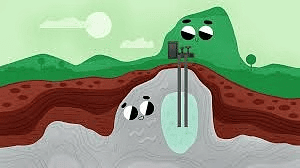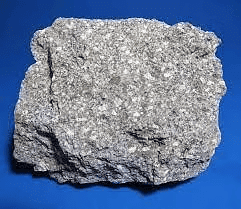Rocks And Minerals Class 5 Worksheet Science
Q1: Multiple Choice Questions
(i) Which of the following is a type of rock?
(a) Granite
(b) Diamond
(c) Iron
(d) Sand
Ans: (a)
Granite is a type of igneous rock formed from the cooling of magma or lava.
(ii) Which statement is true regarding fossil fuels?
(a) Fossil fuels are formed from the remains of dinosaurs only.
(b) Coal is a type of fossil fuel formed from dead plants, while petroleum is formed from the remains of sea plants and animals.
(c) Fossil fuels are renewable energy sources that can be replenished quickly.
(d) Both coal and petroleum are found only on the surface of the Earth.
Ans: (b)
Fossil fuels like coal and petroleum are formed over millions of years from the remains of ancient organisms, with coal coming primarily from terrestrial plants and petroleum from marine life.
(iii) Which type of rock is formed from cooled magma or lava?
(a) Igneous
(b) Sedimentary
(c) Metamorphic
(d) None of the above
Ans: (a)
Igneous rocks are formed from the cooling and solidification of magma or lava.
(iv) Which of the following is a common mineral found in rocks?
(a) Quartz
(b) Gold
(c) Silver
(d) Copper
Ans: (a)
Quartz is a common mineral found in rocks. It is made up of silicon and oxygen and is found in many types of rocks, including granite and sandstone.
(v) Which type of rock is formed by the compaction and cementation of sediment?
(a) Igneous
(b) Sedimentary
(c) Metamorphic
(d) None of the above
Ans: (b)
Sedimentary rocks are formed by the compaction and cementation of sediment, which is made up of small particles of rocks, minerals, and organic materials.
Q2: Fill in the Blanks
(i) __________ is the process of breaking down rocks into smaller particles.
Ans: Weathering is the process of breaking down rocks into smaller particles.
(ii) __________ is the hardest mineral found on Earth.
Ans: Diamond is the hardest mineral found on Earth.
(iii) Rocks that are formed from the accumulation of sediments are called __________ rocks.
Ans: Rocks that are formed from the accumulation of sediments are called sedimentary rocks.
(iv) __________ rock is formed when magma or lava cools and solidifies.
Ans: An igneous rock is formed when magma or lava cools and solidifies.
(v) The process of changing one type of rock into another is called the __________ cycle.
Ans: The process of changing one type of rock into another is called the rock cycle.
Q3: Match the Column

Ans: (i) : (b) Granite
(ii) : (d) Sandstone
(iii) : (c) Gneiss
(iv) : (a) Weathering
(v) : (e) Rock Cycle
Q4: True or False
(i) Minerals are naturally occurring substances found in the Earth's crust.
Ans: True
Minerals are naturally occurring substances found in the Earth's crust. They are formed by geological processes and have a definite chemical composition and crystal structure.
(ii) Magma is molten rock material found beneath the Earth's surface.
Ans: True
Magma is molten rock material found beneath the Earth's surface. When magma reaches the surface, it is called lava.
(iii) Marble is an example of an igneous rock.
Ans: False
Marble is an example of a metamorphic rock, not an igneous rock. It is formed from the metamorphism of limestone or dolomite.

(iv) All rocks are made up of minerals.
Ans: True
All rocks are made up of minerals. The minerals determine the properties and composition of the rock.
(v) Fossils can be found in metamorphic rocks.
Ans: False
Fossils are usually found in sedimentary rocks, not metamorphic rocks. Fossils are the remains or traces of ancient plants and animals that have been preserved in rock formations.
Q5: Short Answer Questions
(i) What are the three types of rocks? Give one example for each.
Ans: The three types of rocks are igneous, sedimentary, and metamorphic. Examples are:
Igneous - Granite;
Sedimentary - Sandstone;
Metamorphic - Marble.
(ii) What is the difference between a rock and a mineral?
Ans: A rock is a naturally occurring solid substance composed of one or more minerals or mineraloids. Minerals are naturally occurring inorganic substances with a definite chemical composition and crystalline structure.
(iii) How are metamorphic rocks formed?
Ans: Metamorphic rocks are formed when existing rocks are subjected to heat, pressure, or chemically active fluids, causing their minerals to recrystallize or change in composition. This process changes the original rock into a new type of rock.
(iv) What is the process of weathering?
Ans: Weathering is the process of breaking down rocks, soils, and minerals through contact with the Earth's atmosphere, water, and living organisms. It can be caused by physical, chemical, or biological processes.
(v) What are the uses of rocks and minerals?
Ans: Rocks and minerals have various uses, including building materials (e.g., marble, granite), sources of metals (e.g., copper, iron), and gemstones (e.g., diamond, ruby). Minerals such as gypsum and salt are used in agriculture, while rocks like limestone and sandstone are used in construction.
|
42 videos|364 docs|45 tests
|
FAQs on Rocks And Minerals Class 5 Worksheet Science
| 1. What are the different types of rocks? |  |
| 2. How are minerals different from rocks? |  |
| 3. What are some common uses of rocks and minerals? |  |
| 4. How do we classify minerals? |  |
| 5. Why are fossils found in sedimentary rocks? |  |
















